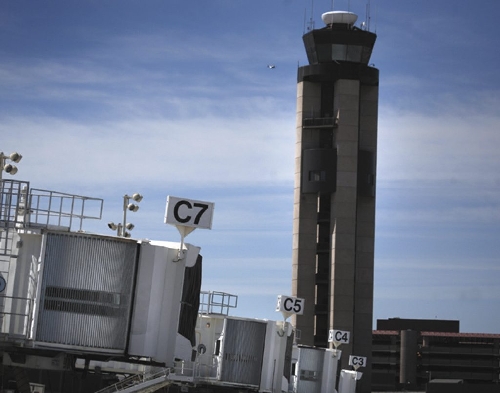McCarran’s new air traffic control tower will stand twice as tall as current one

Within four years, the air traffic controllers who maintain the safe distances among planes flying into and out of McCarran International Airport should have a little more separation of their own.
On Tuesday, federal and local officials broke ground for the airport’s $99 million control tower, the planning of which started nearly a decade ago and which is expected to go into operation in early 2015. Most noticeable to passers-by will be the 352-foot height of the new tower — close to double the 185 feet of the current tower, which went into service in 1983.
When they move into the new tower, the controllers will work out of an 850-square-foot cab, the top recognizable at airports nationwide for the angled windows on all sides, which will be 62 percent larger than the current cab. Because the number of controllers on duty at McCarran has grown from six to 14 over the past 28 years, the environmental report evaluating the new tower termed the old one “extremely crowded.”
The extra controllers came on as traffic at McCarran more than quadrupled to 619,000 flights in 2006 from the 140,000 flights a year when the current tower opened, airport statistics show. The total dropped to 505,000 last year as airlines, air taxis and private planes reduced their flying times.
Construction around the airport over the years has created several blind spots from the current tower, so aircraft must be tracked by radar in those places.
The new tower will be tall enough to overcome this shortcoming and will stand by itself between the parking garage and Terminal 3, now under construction.
“Visibility is very important,” Federal Aviation Administration chief Randy Babbitt said at the ceremony. “You want to be able to see the entire field.”
However, he and other officials said the current tower was safe if not optimal.
According to an FAA report published in 2005, the McCarran tower was originally budgeted for $13.2 million nine years ago, based on a plan to construct a new tower on the current base. But after studying seven sites, the agency decided to build from the ground up at a different location at the much higher price.
Besides having more working room, the new tower will be designed to allow easier installation of new electronics as they come into use, FAA spokesman Ian Gregor said. The current tower has equipment embedded into the structure, requiring extra carpentry to put in replacements.
The base of the new tower at 52,800 square feet, almost quadruple the current one, will allow the FAA to consolidate several functions that are now spread among several locations. For example, a training simulator now at the North Las Vegas Airport will be moved.
The new structure will take about two years to build, and more than a year after that all the electronics and other air traffic control hardware will be installed.
The current tower will be demolished when operations move to the new one, but the base’s fate has not been decided.
At peak times, about 80 construction people will work on the site.
U.S. Sen. Harry Reid used the ceremony to note that he had attached the funding for the tower to another bill as an earmark.
“People opposing earmarks are really short-sighted,” he said.
Fiscal conservatives in Washington have cited the widespread use of earmarks in Congress as a culprit in creating trillion-dollar federal deficits.
Contact reporter Tim O’Reiley at
toreiley@reviewjournal.com or 702-387-5290.